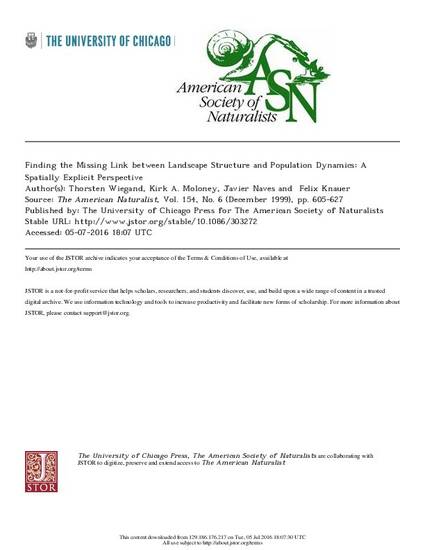
Article
Finding the missing link between landscape structure and population dynamics: a spatially explicit perspective
The American Naturalist
Document Type
Article
Disciplines
Publication Version
Published Version
Publication Date
12-1-1999
DOI
10.1086/303272
Abstract
We construct and explore a general modeling framework that allows for a systematic investigation of the impact of changes in landscape structure on population dynamics. The essential parts of the framework are a landscape generator with independent control over landscape composition and physiognomy, an individual-based spatially explicit population model that simulates population dynamics within heterogeneous landscapes, and scale-dependent landscape indices that depict the essential aspects of landscape that interact with dispersal and demographic processes. Landscape maps are represented by a grid of 50#50 cells and consist of good-quality, poorquality, or uninhabitable matrix habitat cells. The population model was shaped in accordance to the biology of European brown bears (Ursus arctos), and demographic parameters were adjusted to yield a source-sink configuration. Results obtained with the spatially explicit model do not confirm results of earlier nonspatial source-sink models where addition of sink habitat resulted in a decrease of total population size because of dilution of high-quality habitat. Our landscape indices, which describe scale-dependent correlation between and within habitat types, were able to explain variations in variables of population dynamics (mean number of females with sink home ranges, mean number of females with source home ranges, and mean dispersal distance) caused by different landscape structure. When landscape structure changed, changes in these variables generally followed the corresponding change of an appropriate landscape index in a linear way. Our general approach incorporates source-sink dynamics as well as metapopulation dynamics, and the population model can easily be modified for other species groups.
Copyright Owner
The University of Chicago
Copyright Date
1999
Language
en
File Format
application/pdf
Citation Information
Thorsten Wiegand, Kirk A. Moloney, Javier Naves and Felix Knauer. "Finding the missing link between landscape structure and population dynamics: a spatially explicit perspective" The American Naturalist Vol. 154 Iss. 6 (1999) p. 605 - 627 Available at: http://works.bepress.com/kirk-moloney/8/

This article is from The American Naturalist 154 (1999): 605, doi: 10.1086/303272. Posted with permission.